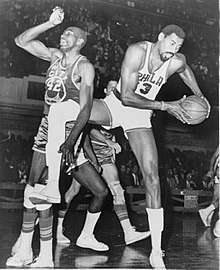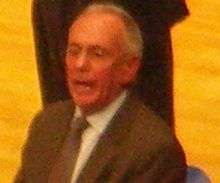1963 NBA draft
The 1963 NBA draft was the 17th annual draft of the National Basketball Association (NBA). The draft was held on April 30 and May 7, 1963, before the 1963–64 season. In this draft, nine NBA teams took turns selecting amateur U.S. college basketball players. A player who had finished his four-year college eligibility was eligible for selection. If a player left college early, he would not be eligible for selection until his college class graduated. In each round, the teams select in reverse order of their win–loss record in the previous season. Before the draft, a team could forfeit its first-round draft pick and then select any player from within a 50-mile radius of its home arena as their territorial pick.[1][2] The Chicago Zephyrs relocated to Baltimore and became the Baltimore Bullets prior to the draft.[3] The Syracuse Nationals participated in the draft, but relocated to Philadelphia and became the Philadelphia 76ers prior to the start of the season.[4] The draft consisted of 15 rounds comprising 84 players selected.
This draft holds the record for the fewest non-territorial picks who later debuted in the NBA, with 17 (18 if the territorial pick Tom Thacker is included).
| 1963 NBA draft | |
|---|---|
| General information | |
| Sport | Basketball |
| Date(s) | April 30, 1963 (Rounds 1–7) May 7, 1963 (Rounds 8–15) |
| Location | New York City, New York |
| Overview | |
| 84 total selections in 15 rounds | |
| League | NBA |
| Territorial pick(s) | Tom Thacker, Cincinnati Royals |
| First selection | Art Heyman, New York Knicks |
Draft selections and draftee career notes
Tom Thacker from the University of Cincinnati was selected before the draft as Cincinnati Royals' territorial pick. Art Heyman from Duke University was selected first overall by the New York Knicks. Two players from this draft, Nate Thurmond and Gus Johnson, have been inducted to the Basketball Hall of Fame.[5] Thurmond was also named in the 50 Greatest Players in NBA History list announced at the league's 50th anniversary in 1996.[6] Thurmond's achievements include seven All-Star Game selections and five All-Defensive Team selections.[7] Johnson's achievement include four All-NBA Team selections and five All-Star Game selections.[8] Two players from this draft, 4th pick Eddie Miles and 13th pick Jim King, have also been selected to an All-Star Game.[9][10]
Reggie Harding, who was the first player drafted out of high school when he was drafted the previous year, was drafted again by the Detroit Pistons with the 48th pick. He finally enter the league after spending a year in the Midwest Professional Basketball League (MPBL) due to the rules that prevent a high school player to play in the league until one year after his high school class graduated.[11][12] Larry Brown from the University of North Carolina was selected with the 55th pick. However, he never played in the NBA. He spent his playing career within the Amateur Athletic Union (AAU) before joining the newly formed American Basketball Association (ABA) in 1967.[13] He played there for five seasons, earning one All-ABA Team selection and three ABA All-Star Game selections.[14] After his playing career, he became a head coach. He coached nine NBA teams, most recently with the Charlotte Bobcats (now Charlotte Hornets). He won the NBA championship with the Detroit Pistons in 2004 and went to the NBA Finals two other times; with the Philadelphia 76ers in 2001 and with the Pistons in 2005.[15] In between his NBA coaching career, he also coached the Kansas Jayhawks of the University of Kansas for five seasons, winning the National Collegiate Athletic Association (NCAA) championship in 1988. He is the only coach to win both an NCAA title and an NBA championship. As a player, he won the gold medal with the United States national basketball team at the 1964 Olympic Games. He then coached the U.S. national team to a bronze medal at the 2004 Olympic Games, becoming the only U.S. male basketball participant to both play and coach in the Olympics.[16] Rod Thorn, the 2nd pick, also had a coaching career. He was the interim head coach of the Chicago Bulls in 1982.[17]
Key
| Pos. | G | F | C |
| Position | Guard | Forward | Center |
| ^ | Denotes player who has been inducted to the Naismith Memorial Basketball Hall of Fame |
| + | Denotes player who has been selected for at least one All-Star Game |
| # | Denotes player who has never appeared in an NBA regular season or playoff game |
Draft

| Round | Pick | Player | Pos. | Nationality | Team | School/club team |
|---|---|---|---|---|---|---|
| T | – | Tom Thacker | G/F | Cincinnati Royals | Cincinnati | |
| 1 | 1 | Art Heyman | G/F | New York Knicks | Duke | |
| 1 | 2 | Rod Thorn | G | Baltimore Bullets | West Virginia | |
| 1 | 3 | Nate Thurmond^ | F/C | San Francisco Warriors | Bowling Green | |
| 1 | 4 | Eddie Miles+ | G/F | Detroit Pistons | Seattle | |
| 1 | 5 | Gerry Ward | G | St. Louis Hawks | Boston College | |
| 1 | 6 | Tom Hoover | C | Syracuse Nationals | Camden Bullets (EPBL)[18] | |
| 1 | 7 | Roger Strickland | F | Los Angeles Lakers | Jacksonville | |
| 1 | 8 | Bill Green# | F | Boston Celtics | Colorado State | |
| 2 | 9 | Jerry Harkness | G | New York Knicks | Loyola (IL) | |
| 2 | 10 | Gus Johnson^ | F/C | Baltimore Bullets | Idaho | |
| 2 | 11 | Gary Hill | G | San Francisco Warriors | Oklahoma City | |
| 2 | 12 | Jerry Smith# | G | Detroit Pistons | Furman | |
| 2 | 13 | Jim King+ | G | Los Angeles Lakers (from Cincinnati)[a] | Tulsa | |
| 2 | 14 | Leland Mitchell# | G | St. Louis Hawks | Mississippi State | |
| 2 | 15 | Hershell West# | G | Syracuse Nationals | Grambling | |
| 2 | 16 | Mel Gibson | G | Los Angeles Lakers | Western Carolina | |
| 2 | 17 | Kenny Saylors# | F | St. Louis Hawks (from Boston) | Arkansas Tech |
Other picks

The following list includes other draft picks who have appeared in at least one NBA game.[19][20]
| Round | Pick | Player | Pos. | Nationality | Team | School/club team |
|---|---|---|---|---|---|---|
| 3 | 24 | Jerry Greenspan | F | Syracuse Nationals | Maryland | |
| 5 | 43 | Larry Jones | G/F | Los Angeles Lakers | Toledo | |
| 6 | 48 | Reggie Harding | C | Detroit Pistons | Holland Oilers (MPBL)[21] | |
| 7 | 59 | Ken Rohloff | G | St. Louis Hawks | NC State | |
| 8 | 63 | Freddie Crawford | G/F | New York Knicks | St. Bonaventure |
Trades
- a On September 14, 1962, the Los Angeles Lakers acquired the a second-round pick from the Cincinnati Royals in exchange for Tom Hawkins.[22] The Lakers used the pick to draft Jim King.
References
- General
- "Complete First Round Results 1960–69". NBA.com. Turner Sports Interactive, Inc. Archived from the original on 3 December 2009. Retrieved January 8, 2010.
- "1963 NBA Draft". basketball-reference.com. Archived from the original on 3 January 2010. Retrieved January 27, 2010.
- "1962–1966 NBA Drafts". The Association for Professional Basketball Research. Retrieved January 26, 2010.
- "1963 NBA Draft". The Draft Review. Retrieved January 27, 2010.
- Specific
- "How the NBA draft became a lottery". The Seattle Times. The Seattle Times Company. May 21, 2007. Retrieved September 10, 2009.
- "Lakers Select Baylor In NBA Draft Meeting". The Daily Collegian. Pennsylvania State University. April 23, 1958. Archived from the original on April 10, 2016. Retrieved September 29, 2009.
- Hareas, John (August 6, 2001). "A Colorful Tradition". NBA.com/Wizards. Turner Sports Interactive, Inc. Retrieved January 26, 2010.
- "Sixers History". NBA.com/Sixers. Turner Sports Interactive, Inc. Archived from the original on 19 January 2010. Retrieved January 27, 2010.
- "Naismith Memorial Basketball Hall of Fame Inductees". basketball-reference.com. Retrieved October 28, 2009.
- "The NBA's 50 Greatest Players". NBA.com. Turner Sports Interactive, Inc. Archived from the original on 6 April 2010. Retrieved April 13, 2010.
- "Nate Thurmond Bio". NBA.com. Turner Sports Interactive, Inc. Retrieved April 13, 2010.
- "Gus Johnson Statistics". basketball-reference.com. Archived from the original on 10 April 2010. Retrieved April 13, 2010.
- "Eddie Miles Statistics". basketball-reference.com. Retrieved April 13, 2010.
- "Jim King Statistics". basketball-reference.com. Archived from the original on 15 May 2010. Retrieved April 13, 2010.
- Hilton, Dan (July 14, 2008). "Doesn't the Extra Year Help Teams?". NBA.com/Suns. Turner Sports Interactive, Inc. Archived from the original on 21 January 2010. Retrieved January 27, 2010.
- "Pistons Can't Use 7-Foot Prep". Lawrence Journal-World. July 3, 1962. Retrieved April 13, 2010.
- "Lawrence "Larry" Brown Bio". International Jewish Sports Hall of Fame. Retrieved April 13, 2010.
- "Larry Brown Statistics". basketball-reference.com. Retrieved April 13, 2010.
- "Larry Brown Coaching Record". basketball-reference.com. Archived from the original on 12 April 2010. Retrieved April 13, 2010.
- "Bobcats Name Larry Brown Head Coach". NBA.com/Bobcats. Turner Sports Interactive, Inc. April 29, 2008. Archived from the original on 11 April 2010. Retrieved April 13, 2010.
- "Rod Thorn Coaching Record". basketball-reference.com. Archived from the original on 7 May 2010. Retrieved May 19, 2010.
- "New Balto. 5 gets 2 of 17 draftees". Baltimore Afro-American. May 4, 1963. Retrieved April 16, 2010.
- https://www.basketball-reference.com/draft/NBA_1963.html
- http://basketball.realgm.com/nba/draft/past_drafts/1963
- "This Game Called What's The Name". Toledo Blade. January 7, 1963. Retrieved April 13, 2010.
- "Tom Hawkins Statistics". basketball-reference.com. Retrieved January 28, 2010.